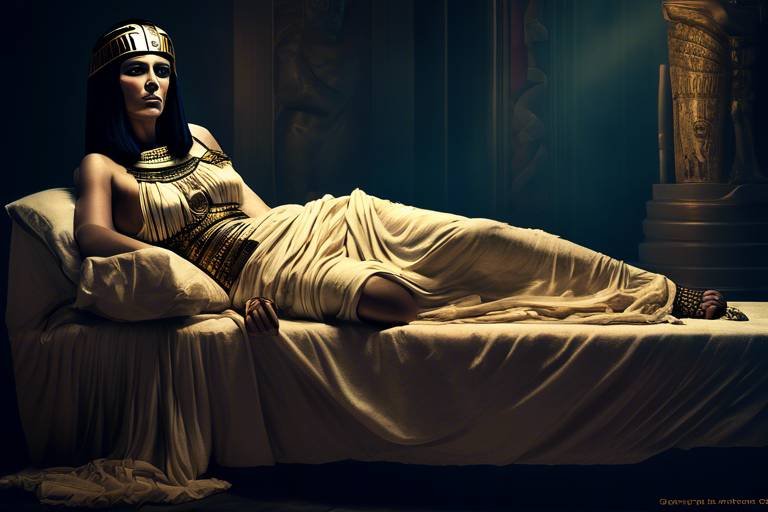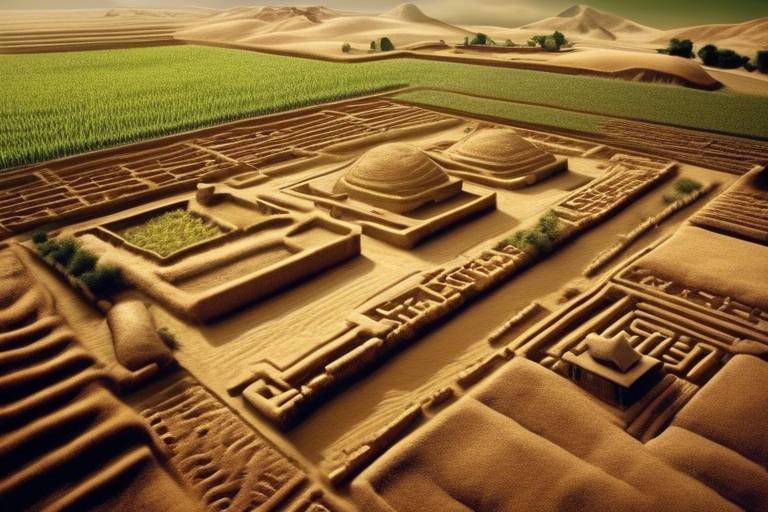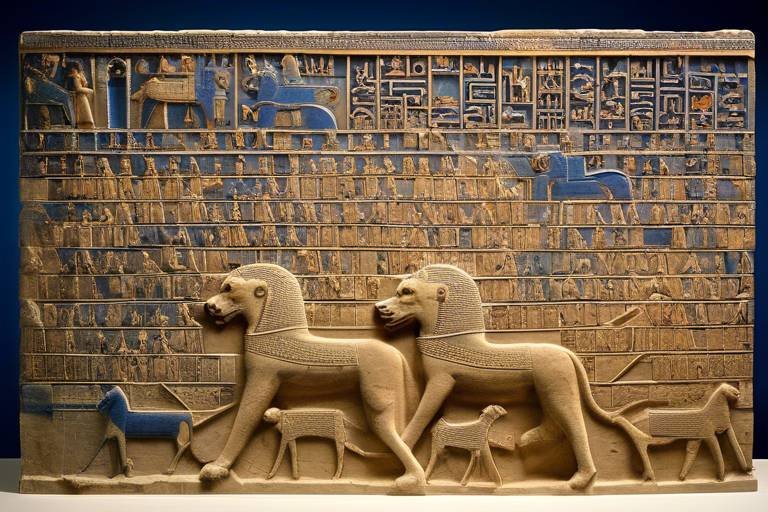The Secrets of Ancient Egyptian Art
Exploring the fascinating world of ancient Egyptian art reveals a treasure trove of secrets waiting to be unveiled. The art of this ancient civilization is a tapestry woven with symbolism, techniques, and cultural significance, offering a glimpse into the beliefs, practices, and creativity of the people who lived along the Nile.

Symbols and Meanings
The ancient Egyptian art is rich in symbolism, with each symbol carrying deep meanings and significance. One of the most iconic symbols is the Ankh, representing life and immortality. It is often depicted being held by gods and pharaohs, symbolizing their eternal power and connection to the divine. The scarab beetle is another common symbol, symbolizing rebirth and regeneration due to its association with the sun god Ra rolling the sun across the sky. The Eye of Horus, also known as the Wedjat eye, represents protection, royal power, and good health, with its distinctive shape believed to ward off evil spirits.
A closer look at these symbols reveals the intricate layers of meaning woven into ancient Egyptian art. The Ankh, with its looped top and cross-like shape, embodies the concept of eternal life and the union of male and female principles. The scarab beetle, revered for its ability to transform dung into life, symbolizes the cycle of life, death, and rebirth. The Eye of Horus, with its distinctive markings resembling a falcon's eye, is a potent symbol of protection and healing, believed to offer guidance and ward off malevolent forces.
Ancient Egyptian artists masterfully incorporated these symbols into their artworks, infusing them with layers of meaning that resonate to this day. Whether carved into stone, painted on papyrus, or crafted into jewelry, these symbols served as powerful talismans, imbued with the spiritual beliefs and cultural values of the ancient Egyptians.

Artistic Techniques
Exploring the fascinating world of ancient Egyptian art, this article delves into the symbolism, techniques, and cultural significance of artworks from this ancient civilization.
When it comes to ancient Egyptian art, one cannot overlook the innovative techniques that artists employed to create their masterpieces. One of the most striking features is the use of hieroglyphics, the intricate system of writing that also served as decorative elements in art. Imagine the walls of temples and tombs adorned not just with images but with a language intertwined seamlessly within the artwork, telling stories and conveying messages for generations to come.
In addition to hieroglyphics, ancient Egyptian artists were masters of symmetry. The precision and balance in their sculptures and paintings are truly remarkable. Symmetry was not just a visual choice but a reflection of their beliefs in order and harmony in the universe. This meticulous attention to detail is evident in the iconic profile view often seen in their artworks, where figures are depicted with a combination of frontal and profile perspectives, creating a sense of depth and dimension.
Furthermore, the tools and materials used by ancient Egyptian artists played a crucial role in shaping their artistic techniques. From the use of papyrus as a canvas to limestone for sculptures, each material was carefully selected for its symbolic meaning and practicality. Pigments made from natural sources, brushes for delicate details, and chisels for precise carvings all contributed to the intricate craftsmanship displayed in their art.

Materials and Tools
Exploring the fascinating world of ancient Egyptian art, this article delves into the symbolism, techniques, and cultural significance of artworks from this ancient civilization.
Uncover the hidden meanings behind the symbols commonly found in ancient Egyptian art, such as the Ankh, scarab beetle, and Eye of Horus, shedding light on their cultural and religious significance.
Discover the innovative artistic techniques used by ancient Egyptian artists, including the use of hieroglyphics, symmetry, and the iconic profile view in their sculptures and paintings.
Explore the materials and tools that ancient Egyptian artists utilized in their creations. They employed a variety of materials such as papyrus, limestone, and pigments. Tools like brushes and chisels were essential for their intricate craftsmanship.
Examine how ancient Egyptian art portrayed gods and pharaohs, showcasing the divine and royal figures in various artistic forms, from colossal statues to intricate relief carvings.
Unravel the mysteries of funerary art in ancient Egypt, including the elaborate tomb decorations, sarcophagi, and burial rituals that reflect their beliefs in the afterlife.
Delve into the intricate world of ancient Egyptian jewelry and amulets, exploring their symbolic meanings, protective qualities, and the craftsmanship involved in their creation.
Trace the artistic legacy of ancient Egyptian art through history, examining its influence on later civilizations and contemporary art forms, showcasing its enduring impact.
Learn about the rediscovery and preservation efforts of ancient Egyptian art, from the excavation of archaeological sites to the conservation of priceless artifacts, ensuring their legacy for future generations.

Depictions of Gods and Pharaohs
Exploring the fascinating world of ancient Egyptian art, this article delves into the symbolism, techniques, and cultural significance of artworks from this ancient civilization.
Ancient Egyptian art is renowned for its depictions of gods and pharaohs, capturing the divine and royal figures in various artistic forms that reflect their significance in society. From colossal statues to intricate relief carvings, these artworks symbolize power, spirituality, and the connection between the earthly and divine realms.
The portrayal of gods in ancient Egyptian art often showcased them with animal heads, such as the falcon-headed Horus or the jackal-headed Anubis, representing different aspects of nature and the afterlife. These depictions were not merely artistic representations but held deep religious meanings, emphasizing the importance of these deities in Egyptian belief systems.
Pharaohs, as the rulers of ancient Egypt, were also prominently featured in art, depicted in regal attire and symbolic poses to convey their authority and divine status. The artistry involved in creating these images highlighted the pharaoh's role as a bridge between the mortal world and the gods, emphasizing their power and connection to the spiritual realm.
Moreover, the intricate details and precision in portraying gods and pharaohs in Egyptian art reflected the meticulous craftsmanship and artistic skill of ancient Egyptian artisans. The use of vibrant colors, intricate hieroglyphics, and symbolic gestures added layers of meaning to these depictions, showcasing the rich cultural heritage and religious beliefs of the civilization.
Through the art of depicting gods and pharaohs, ancient Egyptian artists immortalized the divine and royal figures, leaving a lasting legacy that continues to fascinate and inspire admirers of art and history around the world.

Funerary Art and Tombs
Exploring the fascinating world of ancient Egyptian art, this article delves into the symbolism, techniques, and cultural significance of artworks from this ancient civilization.
Uncover the hidden meanings behind the symbols commonly found in ancient Egyptian art, such as the Ankh, scarab beetle, and Eye of Horus, shedding light on their cultural and religious significance.
Discover the innovative artistic techniques used by ancient Egyptian artists, including the use of hieroglyphics, symmetry, and the iconic profile view in their sculptures and paintings.
Explore the materials and tools that ancient Egyptian artists utilized in their creations, such as papyrus, limestone, pigments, brushes, and chisels, offering insights into their craftsmanship.
Examine how ancient Egyptian art portrayed gods and pharaohs, showcasing the divine and royal figures in various artistic forms, from colossal statues to intricate relief carvings.
Unravel the mysteries of funerary art in ancient Egypt, including the elaborate tomb decorations, sarcophagi, and burial rituals that reflect their beliefs in the afterlife.
Delve into the intricate world of ancient Egyptian jewelry and amulets, exploring their symbolic meanings, protective qualities, and the craftsmanship involved in their creation.
Trace the artistic legacy of ancient Egyptian art through history, examining its influence on later civilizations and contemporary art forms, showcasing its enduring impact.
Learn about the rediscovery and preservation efforts of ancient Egyptian art, from the excavation of archaeological sites to the conservation of priceless artifacts, ensuring their legacy for future generations.
Stay tuned for some common questions and answers about ancient Egyptian art!

Amulets and Jewelry
Ancient Egyptian jewelry and amulets hold a mystical allure, steeped in symbolism and craftsmanship. These intricate pieces were not merely decorative but held deep significance in the lives of the ancient Egyptians. The amulets, in particular, were believed to possess protective qualities and magical powers, serving as talismans against evil forces and ensuring the wearer's well-being in this life and the afterlife.
The craftsmanship involved in creating these pieces was truly remarkable. Skilled artisans meticulously crafted jewelry and amulets using precious metals such as gold and silver, as well as vibrant gemstones like lapis lazuli and turquoise. The intricate designs often featured symbolic motifs such as the scarab beetle, representing regeneration and protection, or the Eye of Horus, symbolizing healing and divine protection.
Amulets were worn by both the living and the deceased, with specific pieces placed on mummies during the burial process to safeguard the soul's journey to the afterlife. These sacred objects were intricately carved and meticulously detailed, showcasing the artistry and spiritual beliefs of the ancient Egyptians.
Furthermore, the jewelry worn by the ancient Egyptians was not just for adornment but also served as a status symbol and a reflection of one's wealth and social standing. Elaborate necklaces, bracelets, and earrings adorned both men and women, with each piece holding its own symbolic meaning and cultural significance.
Exploring the world of ancient Egyptian jewelry and amulets offers a glimpse into the rich tapestry of beliefs and traditions of this ancient civilization. These exquisite pieces continue to captivate us with their beauty and symbolism, providing a window into the past and a deeper understanding of the people who created them.

Artistic Legacy and Influence
Ancient Egyptian art holds a profound legacy that transcends time, leaving an indelible mark on the world of art and culture. The influence of Egyptian artistic techniques and symbolism can be seen echoing through the corridors of history, shaping the artistic expressions of numerous civilizations that followed.
Imagine the awe-inspiring grandeur of ancient Egyptian temples with their towering statues and intricate hieroglyphic inscriptions, a testament to the artistic prowess of a civilization that revered beauty and harmony. The legacy of Egyptian art is not just a mere remnant of the past but a living testament to the enduring power of creativity and imagination.
From the majestic pyramids of Giza to the exquisite golden mask of Tutankhamun, Egyptian art continues to captivate and inspire artists and art enthusiasts worldwide. The iconic images of pharaohs and gods, rendered with precision and symbolism, have become iconic symbols of power, divinity, and eternal life.
Moreover, the influence of ancient Egyptian art extends beyond its own time, resonating in the art of later civilizations such as the Greeks and Romans. The symmetry, balance, and attention to detail in Egyptian art have left an indelible mark on the artistic sensibilities of the world, shaping architectural designs, sculptures, and paintings for centuries to come.
As we unravel the mysteries of ancient Egyptian art, we not only delve into a distant past but also discover a timeless legacy that continues to inspire and fascinate us. The artistic influence of the ancient Egyptians is a testament to the enduring power of creativity and the universal language of art that transcends boundaries and connects us across time and space.

Rediscovery and Preservation
Rediscovery and Preservation of ancient Egyptian art is a fascinating journey that involves uncovering lost treasures and ensuring their protection for future generations. The process of rediscovery begins with archaeological excavations in ancient sites, where skilled experts carefully unearth artifacts buried for centuries. These discoveries provide valuable insights into the artistic techniques, materials, and cultural practices of the ancient Egyptians.
Once unearthed, these precious artifacts undergo meticulous preservation efforts to protect them from deterioration and ensure their longevity. Conservation specialists use advanced techniques and tools to stabilize fragile pieces, repair damages, and prevent further decay. The goal is to maintain the authenticity and integrity of the artworks while making them accessible to the public for educational and cultural purposes.
One of the key challenges in the preservation of ancient Egyptian art is the delicate balance between conservation and public display. Museums and cultural institutions face the task of showcasing these priceless artifacts to the public while safeguarding them from environmental factors and human handling. Innovative display methods, such as climate-controlled environments and interactive exhibits, are employed to create a captivating and educational experience for visitors.
Collaborative efforts between archaeologists, conservators, historians, and government agencies play a crucial role in the ongoing rediscovery and preservation of ancient Egyptian art. By sharing knowledge, resources, and expertise, these stakeholders work together to protect and promote the rich cultural heritage of Egypt, ensuring that its artistic legacy continues to inspire and captivate audiences around the world.
Frequently Asked Questions
- What are some common symbols found in ancient Egyptian art?
Ancient Egyptian art is rich in symbolism, with common symbols including the Ankh, symbolizing life; the scarab beetle, representing rebirth; and the Eye of Horus, symbolizing protection and good health.
- What artistic techniques were unique to ancient Egyptian art?
Ancient Egyptian artists employed innovative techniques such as the use of hieroglyphics in their artwork, creating symmetrical compositions, and depicting figures in the iconic profile view, all of which are distinctive features of their art style.
- What materials and tools did ancient Egyptian artists use?
Ancient Egyptian artists utilized materials like papyrus for paintings, limestone for sculptures, various pigments for coloring, as well as brushes and chisels for intricate details, showcasing their skill and craftsmanship.
- How did ancient Egyptian art depict gods and pharaohs?
Ancient Egyptian art portrayed gods and pharaohs in various forms, from colossal statues to detailed relief carvings, emphasizing their divine and royal status through intricate artistic representations.
- What is the significance of funerary art in ancient Egypt?
Funerary art in ancient Egypt played a crucial role in burial rituals and beliefs in the afterlife, with elaborate tomb decorations, sarcophagi, and symbolic imagery reflecting their spiritual beliefs and practices.
- What can be learned from ancient Egyptian jewelry and amulets?
Ancient Egyptian jewelry and amulets offer insights into their symbolic meanings, protective qualities, and the exceptional craftsmanship of artisans, showcasing the importance of adornments in their culture.
- How did ancient Egyptian art influence later civilizations?
Ancient Egyptian art had a lasting impact on later civilizations, with its artistic legacy seen in various art forms and styles throughout history, demonstrating the enduring influence of this ancient culture.
- What efforts are made to preserve ancient Egyptian art?
Efforts to preserve ancient Egyptian art include excavation of archaeological sites, conservation of artifacts, and ongoing research to safeguard these valuable pieces of history for future generations to appreciate and study.



















